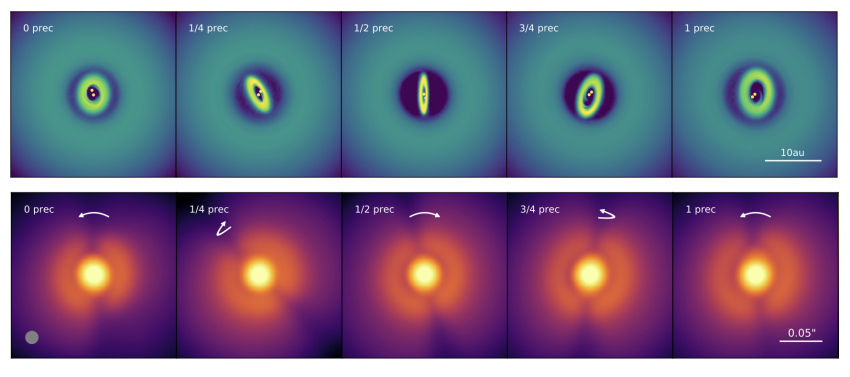Astronomers from the University of Warwick reveal a new phenomenon dubbed the “rocking shadow” effect that describes how discs in forming planetary systems are oriented, and how they move around their host star. The effect also gives clues as to how they might evolve with time. Dr Rebecca Nealon presented the new work this week at the 2022 National Astronomy Meeting at the University of Warwick.
Stars are born when a large cloud of gas and dust collapses in on itself. The leftover material that doesn’t make it into the star ends up circling around it, not unlike how water swirls around the drain before falling in. This swirling mass of gas and dust is called a protoplanetary disc, and it’s where planets like the Earth are born.
Protoplanetary discs are often thought to be shaped like dinner plates – thin, round and flat. However, recent telescope images from the Atacama Large Millimeter/Submillimeter Array (ALMA) show that this is not always the case. Some of the discs seen by ALMA have shadows on them, where the part of the disc closest to the star blocks some of the stellar light and casts a shadow onto the outer part of the disc. From this shadow pattern, it can be inferred that the inner part of the disc is oriented completely differently to the outer part, in what is called a broken disc.
In this research, the team used high performance computers to run three-dimensional simulations of a broken disc. The team then produced a mock observation, modelling what such a disc would look like if it were to be observed through a telescope, and how it would change over time.
As the inner disc moved through the gravitational pull of the central star, the shadow it cast moved across the outer disc. But instead of the shadow pattern moving around the disc like a clock-hand as expected, it rocked back and forth with a see-saw-like motion. So although the inside disc kept turning in the same direction, its shadow looked like it was rocking forwards and backwards. The team suggest this is caused by a geometric projection effect, which is likely to occur in all broken discs.
Movie made from the 3D simulation of a disk in a forming planetary system. The inner disk casts shadows on the outer disk, which rock back and forth. Credit: Rebecca Nealon / University of Warwick
Dr Nealon says: “JWST promises to give us a look at embryonic planetary systems in unprecedented detail, and with our new models we’ll be able to find out a lot more about the birth of planets.”
Media contacts
Dr Robert Massey
Royal Astronomical Society
Mob: +44 (0)7802 877699
nam-press@ras.ac.uk
Cait Cullen
Royal Astronomical Society
nam-press@ras.ac.uk
Science contacts
Dr Rebecca Nealon
Stephen Hawking Research Fellow
University of Warwick
rebecca.nealon@warwick.ac.uk
Notes for editors
About NAM 2022
The NAM 2022 conference is principally sponsored by the Royal Astronomical Society (RAS), the Science and Technology Facilities Council (STFC) and the University of Warwick. Keep up with the latest conference news on Twitter.
About the Royal Astronomical Society
The Royal Astronomical Society (RAS), founded in 1820, encourages and promotes the study of astronomy, solar-system science, geophysics and closely related branches of science. The RAS organises scientific meetings, publishes international research and review journals, recognises outstanding achievements by the award of medals and prizes, maintains an extensive library, supports education through grants and outreach activities and represents UK astronomy nationally and internationally. Its more than 4,000 members (Fellows), a third based overseas, include scientific researchers in universities, observatories and laboratories as well as historians of astronomy and others.
Follow the RAS on Twitter, Facebook, Instagram and YouTube. Listen and subscribe to the Supermassive Podcast here.
About the Science and Technology Facilities Council
The Science and Technology Facilities Council (STFC) is part of UK Research and Innovation – the UK body which works in partnership with universities, research organisations, businesses, charities, and government to create the best possible environment for research and innovation to flourish. STFC funds and supports research in particle and nuclear physics, astronomy, gravitational research and astrophysics, and space science and also operates a network of five national laboratories, including the Rutherford Appleton Laboratory and the Daresbury Laboratory, as well as supporting UK research at a number of international research facilities including CERN, FERMILAB, the ESO telescopes in Chile and many more.
STFC's Astronomy and Space Science programme provides support for a wide range of facilities, research groups and individuals in order to investigate some of the highest priority questions in astrophysics, cosmology and solar system science. STFC's astronomy and space science programme is delivered through grant funding for research activities, and also through support of technical activities at STFC's UK Astronomy Technology Centre and RAL Space at the Rutherford Appleton Laboratory. STFC also supports UK astronomy through the international European Southern Observatory and the Square Kilometre Array Organisation.
Follow STFC on Twitter.
About the University of Warwick
The University of Warwick is one of the world’s leading research institutions, ranked in the UK’s top 10 and world top 80 universities. Since its foundation in 1965 Warwick has established a reputation of scientific excellence, through the Faculty of Science, Engineering and Medicine (which includes WMG and the Warwick Medical School).


